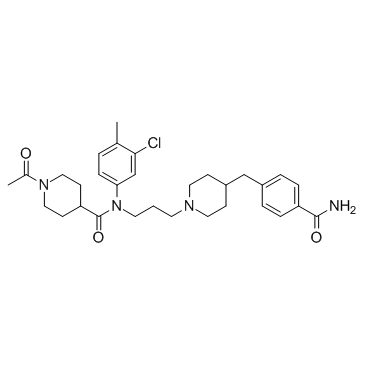333994-00-6
| Name | 1-acetyl-N-[3-[4-[(4-carbamoylphenyl)methyl]piperidin-1-yl]propyl]-N-(3-chloro-4-methylphenyl)piperidine-4-carboxamide |
|---|---|
| Synonyms |
tbr-220
tak-220 1-ACETYL-N-(3-(4-(4-CARBAMOYLBENZYL)PIPERIDIN-1-YL)PROPYL)-N-(3-CHLORO-4-METHYLPHENYL)PIPERIDINE-4-CARBOXAMIDE |
| Description | TAK-220 is a selective and orally bioavailable CCR5 antagonist, with IC50s of 3.5 nM and 1.4 nM for inhibition on the binding of RANTES and MIP-1α to CCR5, respectively, but shows no effect on the binding to CCR1, CCR2b, CCR3, CCR4, or CCR7; TAK-220 also selectively inhibits HIV-1, with EC50s of 1.2 nM (HIV-1 KK), 0.72 nM (HIV-1 CTV), 1.7 nM (HIV-1 HKW), 1.7 nM (HIV-1 HNK), 0.93 nM (HIV-1 HTN), and 0.55 nM (HIV-1 HHA), and EC90s of 12 nM (HIV-1 KK), 5 nM (HIV-1 CTV), 12 nM (HIV-1 HKW), 28 nM (HIV-1 HNK), 15 nM (HIV-1 HTN), and 4 nM (HIV-1 HHA) in PBMCs. |
|---|---|
| Related Catalog | |
| Target |
MIP-1α-CCR5:1.4 nM (IC50, in CHO cells) RANTES-CCR5:3.5 nM (IC50, in CHO cells) HIV-1 (HHA):0.55 nM (EC50, in PBMCs) HIV-1 (CTV):0.72 nM (EC50, in PBMCs) HIV-1 (HTN):0.93 nM (EC50, in PBMCs) HIV-1 (KK):1.2 nM (EC50, in PBMCs) HIV-1 (HKW):1.7 nM (EC50, in PBMCs) HIV-1 (HNK):1.7 nM (EC50, in PBMCs) HIV-1 (HHA):4 nM (EC90, in PBMCs) HIV-1 (CTV):5 nM (EC90, in PBMCs) HIV-1 (KK):12 nM (EC90, in PBMCs) HIV-1 (HKW):12 nM (EC90, in PBMCs) HIV-1 (HTN):15 nM (EC90, in PBMCs) HIV-1 (HNK):28 nM (EC90, in PBMCs) |
| In Vitro | TAK-220 is a selective CCR5 antagonist, with IC50s of 3.5 nM and 1.4 nM for inhibition on the binding of RANTES and MIP-1α to CCR5 in CHO cells, respectively, but shows no effect on the binding to CCR1, CCR2b, CCR3, CCR4, or CCR7. TAK-220 (0-1000 nM) interacts with CCR5 but not with RANTES and inhibits the CCR5-mediated Casup>2+ signaling. TAK-220 inhibits R5 HIV-1 (JR-FL) envelope-mediated membrane fusion, with an IC50 value of 0.42 nM, but does not alter X4 HIV-1 (HXB2) envelope-mediated membrane fusion. TAK-220 also selectively inhibits HIV-1, with EC50s of 1.2 nM (HIV-1 KK), 0.72 nM (HIV-1 CTV), 1.7 nM (HIV-1 HKW), 1.7 nM (HIV-1 HNK), 0.93 nM (HIV-1 HTN), and 0.55 nM (HIV-1 HHA), and EC90s of 12 nM (HIV-1 KK), 5 nM (HIV-1 CTV), 12 nM (HIV-1 HKW), 28 nM (HIV-1 HNK), 15 nM (HIV-1 HTN), and 4 nM (HIV-1 HHA) in PBMCs[1]. TAK-220 shows potent inhibitory activity against the R5 isolates, with IC50s of 3.12 nM against HIV-1 R5-08, 13.47 nM against HIV-1 R5-06, and 2.26 nM against HIV-1 R5-18. TAK-220 (>100 nM) has no toxicity in uninfected PBMCs[2]. |
| Cell Assay | PHA-stimulated PBMCs are inoculated with 1,000 to 1,400 CCID50s of R5 HIV-1 (JR-FL) or X4 HIV-1 (IIIB) or with 13 to 55 ng of p24 of HIV-1 clinical isolates per 4 × 106 cells and incubated for 4 h. The cells are washed to remove unadsorbed viral particles and seeded into a 96-well plate (2 × 105 cells/well) with culture medium containing various concentrations of TAK-220. The effects of high concentrations of human serum (HS) on the anti-HIV-1 activity of TAK-220 are examined with RPMI 1640 medium supplemented with either 20% FBS alone or 40% human type AB serum plus 10% FBS, 100 U/mL recombinant human interleukin 2, and antibiotics. On day 4 after infection, the cells are subcultured at 1:2 with culture medium containing the same concentrations of the test compounds. On day 7 after infection, the culture supernatants are collected and their p24 antigen levels are determined with a p24 antigen enzyme-linked immunosorbent assay kit[1]. |
| References |
| Molecular Formula | C31H41ClN4O3 |
|---|---|
| Molecular Weight | 553.13500 |
| Exact Mass | 552.28700 |
| PSA | 86.95000 |
| LogP | 5.25970 |
| Storage condition | 2-8℃ |
